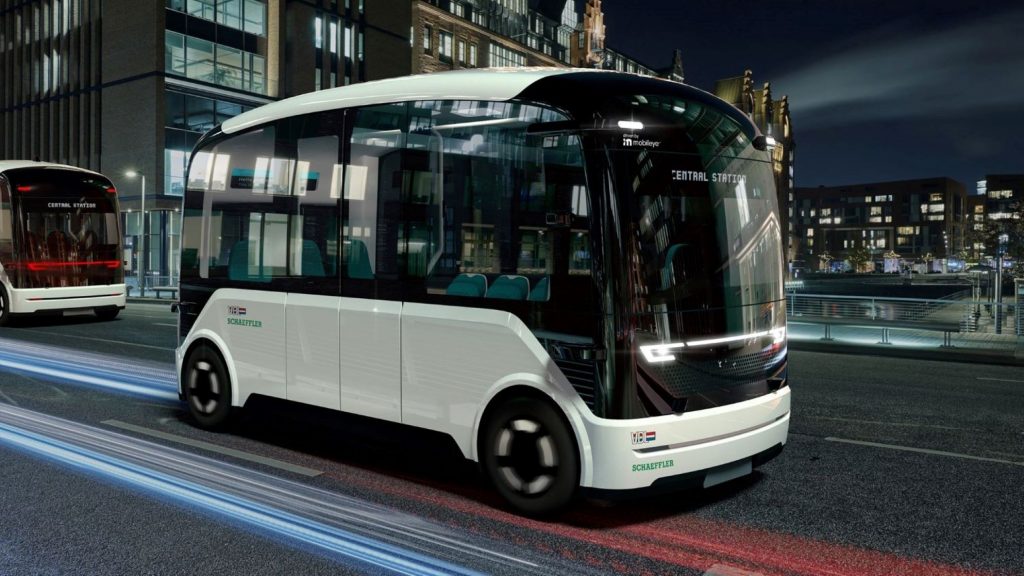
At the IAA Mobility 2023 show in Munich next week, Schaeffler and VDL Groep will be showcasing a jointly developed self-driving shuttle for public transport, with Mobileye providing the SAE Level 4 automated driving system. They are currently in advanced negotiations with public transport authorities and operators to start pilot projects.
The envisaged strategic cooperation underlines the importance of getting involved in developments at an early stage as the partners are expecting demand for self-driving shuttle services to take off, especially in many major cities in Europe, North America, and parts of Asia by the end of this century. According to their roadmap, testing for the vehicles on the streets will most likely start in 2025.
VDL Groep is an innovator in bus and car manufacturing and a European frontrunner in the electrification of heavy-duty vehicles. Schaeffler, a leading automotive supplier of systems and components for electrified powertrains and innovative steering systems, has introduced a rolling chassis that combines a fully electric powertrain, steer-by-wire system, and battery in a modular solution.
As the partners see it, the concept of mobility is currently being reinvented globally. Many metropolitan areas are supplementing their mobility offerings with alternative concepts to provide more sustainable and easily accessible solutions. Public transport operators are increasingly exploring autonomous driving solutions, allowing for increasing traffic volumes in the face of driver shortages. Especially in off-peak hours, they believe that larger vehicles will progressively be replaced by smaller, self-driving vehicles and on-demand services to make for locally-emissions-free and low-noise public transport.
“Self-driving shuttle vehicles will become integral elements of modern mobility ecosystems,” said Klaus Rosenfeld, CEO of Schaeffler AG. “They will bring people safely, quickly, and easily from A to B and increase accessibility to mobility for everyone living in cities and rural areas. We at Schaeffler want to support this development with best-in-class systems engineering as well as innovative automotive technology in a sustainable manner.”
“Autonomous shuttles are going to play an important role in our future mobility needs,” added Willem van der Leegte, President and CEO of VDL Groep. “This vehicle concept fits seamlessly into our broad mobility solution covering design, electrification, connectivity, autonomy, and services.”
Both execs were excited by the prospects of collaboration with Mobileye, whose Drive platform is designed for shuttle vehicles enabling autonomous driving using purpose-built EyeQ processors, redundant sensor systems of surround cameras, lidar or radar sensing, and mapping solutions. The new shuttle is said to have two “deeply integrated” independent sensing systems—one camera-based and one radar- or lidar-based.
“The full potential of autonomous mobility to transform our communities for the better can only be reached if the technologies are safe, accessible, and scalable,” said Johann Jungwirth, Senior Vice President of Autonomous Vehicles at Mobileye. “Working with Schaeffler and VDL Groep, we have the right strategy and teams to make mobility-as-a-service a reality in the very near future.”
Plans call for Germany to be where the newly developed and manufactured shuttles will first operate, benefitting from it being the first country in Europe to approve SAE Level 4 automated driving system use on public roads. Schaeffler and VDL have already started negotiations with operators to acquire pilot projects with the intention of proving the concept and setting up a scalable ecosystem with open interfaces. While production volumes will depend on sales, they expect to produce thousands of vehicles per year starting in 2030 at VDL’s Mobility Innovation Centre in Born, the Netherlands.
The autonomous shuttle being shown at the IAA is 5 m long, 2.2 m wide, and 2.8 m tall, weighing about 5000 kg with a payload of around 1000 kg. It has a maximum speed of 70 km/h, a range of over 350 km per day, and over 100 km on a battery charge. The nine-seater has six fixed and three flexible seats, with large doors and a low entry for wheelchair accessibility. An interior monitoring system will be in direct contact with a remote central control room.

